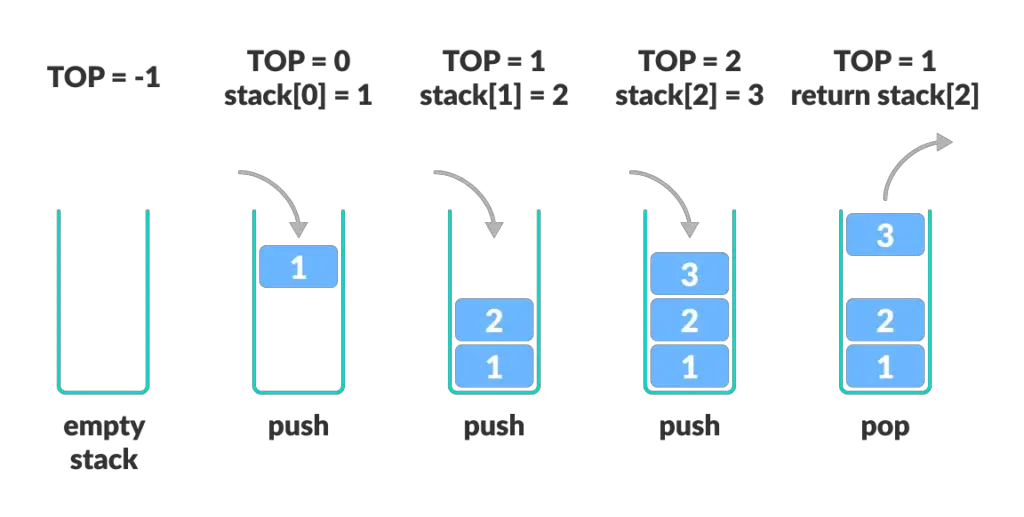Programming can be overwhelming, especially if you are new to computer science. There are many data structures in programming that you have to learn; each has its unique purpose and meets different needs. This article will discuss the fundamental data structures and their differences in simple, clear terms. For those beginning their coding journey or seeking a refresher in computer science, discover how stacks and queues aid in organizing and managing information in both programming and real-world scenarios.
What is a Stack?
A stack is a linear data structure where elements are added and removed only from the top. Let’s assume you were stacking five books one on top of the others on a table; if the conditions were that you could only take one book at a time and asked to remove the fixe books from the table, the only way you could remove them would be to take the ones on the top first. This is how Stacks works in programming.
So, a stack in a data structure works just like your heap of books, and its order is the Last In, First Out (LIFO) sequence.
A stack consists of two major operations, the push and pop operations. A push operation puts a book on your stack, while the pop operation takes a book from the stack.
Characteristics and Operations of a Stack
A stack is a minimal access linear data structure. The defining characteristic of a stack is that every item’s insertion and removal occur at the same end. The top represents the end, while the other is the bottom. The order is described as the Last In, First Out arrangement.
The majority of stacks are designed to be as large as possible. At the top, the only operations allowed are insertion and deletion. A stack can be either void or contain one or more components. The item at the top of the stack is referred to as the top pointer.
These are the basic operations of a stack:
- push: adds an element to the top of the stack
- pop: removes the topmost element from a stack
- isEmpty: checks if a stack is empty
- isFull: checks if a stack is full
- top: displays the topmost element of the stack
Common Applications Of Stacks
There are various applications of a stack in a data structure. Below are a few:
Reverse data
This involves reordering your set of data so the first and last elements are interchanged. For example, reversing the string “Dance” would result in “Ecnad”.
Function calls
Calling a function adds a bookmark to the stack, and returning from a function removes the top bookmark.
Expression Evaluation
Expressions with parentheses or operators with different precedences are evaluated using stacks to ensure the correct order of operations.
Undo/Redo Operations
The undo/redo operations help you store previous states or actions to easily revert changes or visit previous work.
Memory Management
Stacks play a vital role in memory allocation and deallocation. They often manage local variables within functions, ensuring efficient memory usage and preventing leaks.
Example of a Stack in JavaScript
class Stack {
constructor(maxSize) {
this.items = [];
this.maxSize = maxSize; // Maximum size of the stack
}
// Push element to the top of the stack
push(element) {
if (this.isFull()) {
return "Overflow - The stack is full.";
}
this.items.push(element);
}
// Pop element from the top of the stack
pop() {
if (this.isEmpty()) {
return "Underflow - The stack is empty.";
}
return this.items.pop();
}
// Peek at the top element of the stack without removing it
peek() {
return this.items[this.items.length - 1];
}
// Check if the stack is empty
isEmpty() {
return this.items.length === 0;
}
// Check if the stack is full
isFull() {
return this.items.length === this.maxSize;
}
// Get the size of the stack
size() {
return this.items.length;
}
// Clear the stack
clear() {
this.items = [];
}
}
// Example usage:
const myStack = new Stack(5);
myStack.push(1);
myStack.push(2);
myStack.push(3);
console.log("Stack: ", myStack.items); // Output: [1, 2, 3]
console.log("Pop element: ", myStack.pop()); // Output: 3
console.log("Stack after pop: ", myStack.items); // Output: [1, 2]
console.log("Peek at the top: ", myStack.peek()); // Output: 2
console.log("Is the stack empty? ", myStack.isEmpty()); // Output: false
console.log("Stack size: ", myStack.size()); // Output: 2
myStack.clear();
console.log("Stack after clear: ", myStack.items); // Output: []
In the example above, we named the method to check the element on top of stack peek instead of top as described earlier.
What is a Queue?
A queue is a data structure where items are added at one end (the REAR) and removed from the other end (the FRONT). It is like waiting in line for a concert or movie; the first person in line goes in. People wait until the first person has gone in before they can purchase their ticket.
A queue follows the First-In, First-Out (FIFO) rule—what gets in first gets out first. Queues ensure fairness, predictability, and efficiency. Queues also handle insertions and deletions, find the peak element, and check if the queue is empty. Insertion into a queue is called enqueue, and deletion from a queue is called dequeue.
Characteristics and Operations of a Queue
A queue has two distinct ends: Front, where items are removed, and Rear, where items are added. Items are processed in the same order they were added to the queue. Items are arranged in a linear sequence, with one item following another. The size can change as elements are added or removed.
Different operations can be carried out in a queue:
- Enqueue: adds an element to the back of the queue.
- Dequeue: removes an element at the front of the queue.
- Peek: return an element at the front of the queue without removing it.
- Size: return several elements in the queue.
- isEmpty: checks if the queue is empty.
Common Applications of Queues
Scheduling Tasks
Computers use queues to manage tasks that need to be done in a specific order. For example, a web server might use a queue to handle incoming requests from users, ensuring they’re processed one at a time.
Task Management Systems
Task management apps often use queues to organize tasks and prioritize work. Users can add tasks to the queue and then work through them individually, staying focused and productive.
Breadth-First Search (BFS) Algorithms
In graph algorithms, queues are used to explore nodes in a “level-by-level” manner. This technique is useful for finding the shortest paths or checking for network connectivity.
Example of a queue in JavaScript
class Queue {
constructor() {
this.items = [];
}
// Enqueue: Add element to the back of the queue
enqueue(element) {
this.items.push(element);
}
// Dequeue: Remove element from the front of the queue
dequeue() {
if (this.isEmpty()) {
return "Underflow - The queue is empty.";
}
return this.items.shift();
}
// Peek: Get the front element without removing it
peek() {
return this.items[0];
}
// Check if the queue is empty
isEmpty() {
return this.items.length === 0;
}
// Get the size of the queue
size() {
return this.items.length;
}
// Clear the queue
clear() {
this.items = [];
}
}
// Example usage:
const myQueue = new Queue();
myQueue.enqueue(1);
myQueue.enqueue(2);
myQueue.enqueue(3);
console.log("Queue: ", myQueue.items); // Output: [1, 2, 3]
console.log("Dequeue element: ", myQueue.dequeue()); // Output: 1
console.log("Queue after dequeue: ", myQueue.items); // Output: [2, 3]
console.log("Peek at the front: ", myQueue.peek()); // Output: 2
console.log("Is the queue empty? ", myQueue.isEmpty()); // Output: false
console.log("Queue size: ", myQueue.size()); // Output: 2
myQueue.clear();
console.log("Queue after clear: ", myQueue.items); // Output: []
Comparing Stack and Queue Data Structures (Stack vs Queue)
| Parameters | Stack | Queue |
| Order | Stack follows the LIFO (Last In, First Out) order to store elements | Queue follows the FIFO (First In, First Out) order to store elements |
| Operations | The insertion operation is known as push, and the deletion operation is known as pop. | The insertion operation is known as enqueue, and the deletion operation is known as dequeue. |
| Visualization | Stack can be visualized as a vertical collection. | A queue can be visualized as a horizontal collection. |
| Variants | There are no variants or types of the stack. | There are three types of queues: circular, double-ended, and priority. |
| Implementation | Stacks are simpler than queues as they use only one pointer. | Queues are more complex due to the involvement of two pointers, front and rear. |
| Application | A stack is used to solve recursion-based problems | A queue is used to solve sequential processing-based problems. |
| Data Representation | A stack is often implemented with arrays or linked lists | A queue can also be implemented with arrays or doubly linked lists |
Choosing The Right Data Structure For Your Needs
The best data structure depends on the specific requirements of the application. Choosing the right data structure for your needs is crucial, and there are different factors to consider. Factors to consider:
- Understand Your Data
Choose a data structure based on the type and amount of data you’ll be handling and how you’ll need to access and manipulate it. - Consider Operations
The data structure should allow for the necessary operations required by the application to be performed on the data. - Weigh the Trade-Offs
Stacks are good for LIFO access, undo/redo, and function calls, while queues are good for FIFO processing and task scheduling. - Performance of the data structure
Prioritize efficiency for frequently used operations in the data structure. Start simple and optimize later, if needed.
Learning about stacks and queues is essential for anyone who manages data. If you are a programmer or a data analyst, understanding how these structures work and their common uses can help you handle data more efficiently. These structures are versatile and are used in various fields, such as computer science, finance, healthcare, etc. Learn more about stacks and queues to improve your data management skills and problem-solving abilities.









